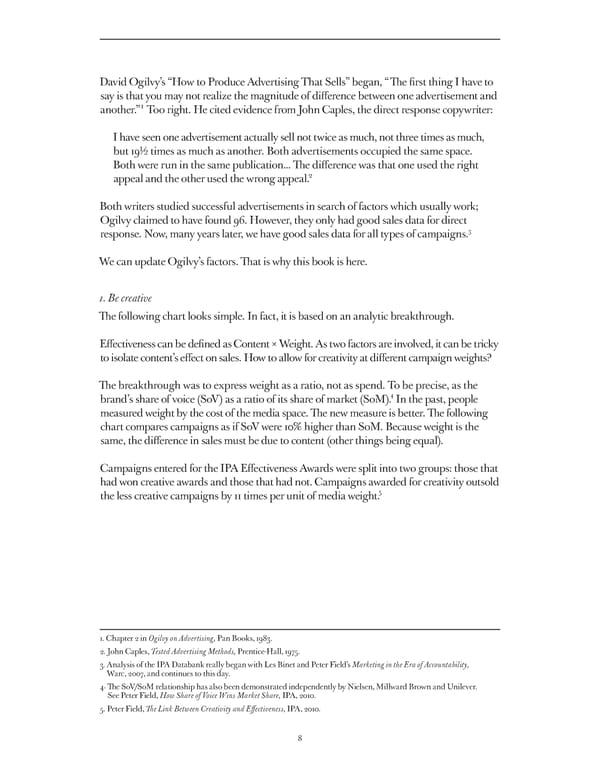David Ogilvy’s “How to Produce Advertising That Sells” began, “The first thing I have to say is that you may not realize the magnitude of difference between one advertisement and another.”1 Too right. He cited evidence from John Caples, the direct response copywriter: I have seen one advertisement actually sell not twice as much, not three times as much, but 19½ times as much as another. Both advertisements occupied the same space. Both were run in the same publication... The difference was that one used the right 2 appeal and the other used the wrong appeal. Both writers studied successful advertisements in search of factors which usually work; Ogilvy claimed to have found 96. However, they only had good sales data for direct 3 response. Now, many years later, we have good sales data for all types of campaigns. We can update Ogilvy’s factors. That is why this book is here. 1. Be creative The following chart looks simple. In fact, it is based on an analytic breakthrough. Effectiveness can be defined as Content × Weight. As two factors are involved, it can be tricky to isolate content’s effect on sales. How to allow for creativity at different campaign weights? The breakthrough was to express weight as a ratio, not as spend. To be precise, as the 4 In the past, people brand’s share of voice (SoV) as a ratio of its share of market (SoM). measured weight by the cost of the media space. The new measure is better. The following chart compares campaigns as if SoV were 10% higher than SoM. Because weight is the same, the difference in sales must be due to content (other things being equal). Campaigns entered for the IPA Effectiveness Awards were split into two groups: those that had won creative awards and those that had not. Campaigns awarded for creativity outsold 5 the less creative campaigns by 11 times per unit of media weight. 1. Chapter 2 in Ogilvy on Advertising, Pan Books, 1983. 2. John Caples, Tested Advertising Methods, Prentice-Hall, 1975. 3. Analysis of the IPA Databank really began with Les Binet and Peter Field’s Marketing in the Era of Accountability, Warc, 2007, and continues to this day. . 4 The SoV/SoM relationship has also been demonstrated independently by Nielsen, Millward Brown and Unilever. See Peter Field, How Share of Voice Wins Market Share, IPA, 2010. 5. Peter Field, The Link Between Creativity and Effectiveness, IPA, 2010. 8
 A Guide To Effectiveness Page 7 Page 9
A Guide To Effectiveness Page 7 Page 9